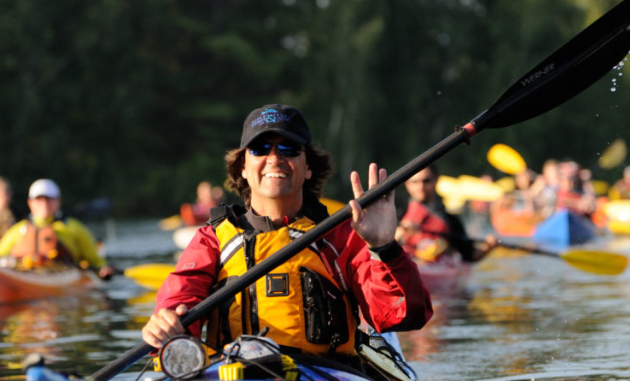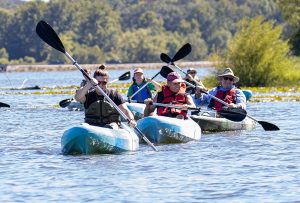

The World of Kayaking: A Symphony of Adventure and Skill
Kayaking is not just a sport; it’s a journey through nature, a test of endurance, and an art of balance and rhythm. Over the years, it has evolved from being a means of transportation to a global phenomenon celebrated in various competitive forms and recreational activities. This documentary delves into the fascinating world of kayaking, highlighting its history, evolution into a competitive game, and its profound impact on both participants and spectators.
—
Origins of Kayaking
Kayaking traces its roots to the indigenous people of the Arctic regions, primarily the Inuit, Aleut, and Yup’ik tribes. These early kayaks, crafted from driftwood and animal skins, were ingeniously designed for hunting and transportation. The word “kayak” itself means “hunter’s boat,” emphasizing its original purpose. Over time, this practical craft transitioned into a recreational and competitive sport, captivating people across the globe.
—
The Transition to Competitive Kayaking
The late 19th and early 20th centuries marked the introduction of kayaking as a recreational activity in Europe. By the 1930s, competitive kayaking became a recognized sport, culminating in its debut at the Berlin Olympics in 1936. Today, kayaking competitions span a wide range of disciplines, including sprint, slalom, freestyle, and marathon, each requiring distinct skills and strategies.
Kayaking Disciplines in Competition
1. Sprint Kayaking:
Often regarded as the formula one of kayaking, sprint races are held on flat water and demand exceptional speed, strength, and endurance. Athletes paddle over distances ranging from 200 to 1,000 meters, often achieving breathtaking speeds.
2. Slalom Kayaking:
A true test of agility and precision, slalom races involve navigating a series of gates on a white-water course. Competitors must paddle against powerful currents, maneuvering through designated gates without touching them—a feat that combines skill, strategy, and split-second decision-making.
3. Freestyle Kayaking:
This discipline brings a creative flair to the sport, where athletes perform acrobatic tricks and stunts on wild rapids. Judged on the complexity and execution of maneuvers, freestyle kayaking is as much an art as it is a sport.
4. Marathon Kayaking:
These endurance-based events cover vast distances, often spanning rivers, lakes, and open seas. Marathon kayaking tests not only the physical stamina of the paddlers but also their mental resilience and navigation skills.
—
The Spirit of Kayaking Games
Competitive kayaking showcases the symbiotic relationship between athletes and nature. Unlike other sports confined to stadiums or arenas, kayaking often unfolds in spectacular natural settings. From roaring rapids to serene lakes, each competition offers a unique canvas that challenges and inspires athletes.
The unpredictability of water conditions adds an element of suspense to kayaking games. Currents, tides, and wind play a significant role in shaping strategies, making adaptability a key trait of successful kayakers. The sport’s dynamic nature keeps both competitors and audiences on the edge of their seats.
—
Technology in Modern Kayaking
The evolution of kayaking has been profoundly influenced by advancements in technology. Today’s kayaks are engineered using lightweight materials like fiberglass, carbon fiber, and Kevlar, offering enhanced speed and maneuverability. Innovations in paddle design have further optimized efficiency, allowing athletes to maximize their power with minimal effort.
Beyond equipment, technology has also enhanced training methods. Athletes now use simulators, video analysis, and biometric tracking to refine their techniques and improve performance. These developments have raised the bar in competitive kayaking, pushing athletes to achieve feats once deemed impossible.
—
Training and the Mental Game
Mastering kayaking requires more than physical prowess. It demands a harmonious blend of strength, technique, and mental fortitude. Training regimens for competitive kayakers include rigorous physical conditioning, technical drills, and mental exercises to build focus and resilience.
Visualization techniques are commonly employed, where athletes mentally rehearse their races, anticipating every twist and turn. This mental preparation is particularly crucial in disciplines like slalom and freestyle, where quick thinking and adaptability are vital.
—
The Global Impact of Kayaking
Beyond the competitive arena, kayaking has become a unifying force, fostering connections among individuals and communities worldwide. Kayaking events and festivals often bring together enthusiasts from diverse backgrounds, celebrating the sport’s universal appeal.
In many developing regions, kayaking initiatives have been instrumental in promoting eco-tourism and river conservation. By highlighting the beauty of natural waterways, these programs encourage sustainable practices and a deeper appreciation for the environment.
—
Kayaking: A Way of Life
For many, kayaking is more than a sport—it’s a lifestyle. It embodies a spirit of exploration and a profound connection with nature. Whether paddling through tranquil lakes or braving tumultuous rapids, kayakers often speak of a meditative state, where the rhythm of their strokes aligns with the flow of the water.
This connection extends to the community of kayakers, bound by a shared passion for the sport. From novice paddlers to seasoned competitors, the kayaking community thrives on camaraderie, mutual support, and a collective respect for the water.
—
The Challenges Ahead
Despite its growing popularity, kayaking faces challenges in the modern era. Climate change poses a significant threat, altering water levels and disrupting ecosystems that support kayaking activities. Additionally, accessibility remains an issue in some regions, where financial and logistical barriers prevent many from experiencing the sport.
Efforts are underway to address these challenges. Organizations like the International Canoe Federation (ICF) and local kayaking clubs are working to promote inclusivity, develop sustainable practices, and raise awareness about the environmental impact of water sports.
—
Looking Ahead
The future of kayaking is bright, buoyed by a new generation of athletes and enthusiasts passionate about pushing the boundaries of the sport. Innovations in technology and training promise to elevate the competitive aspect of kayaking, while grassroots efforts continue to expand its reach as a recreational activity.
As the sport evolves, one thing remains constant: its ability to inspire awe and admiration. Kayaking is not just a game; it’s a celebration of human spirit, resilience, and the timeless allure of water.
—
Conclusion
Kayaking is a symphony of strength, skill, and connection, weaving together the thrill of competition with the serenity of nature. Its journey from ancient hunting craft to modern-day sport reflects humanity’s enduring relationship with water. Whether as a competitive pursuit or a leisurely escape, kayaking continues to captivate a
nd inspire, leaving an indelible mark on those who dare to pick up a paddle and embark on the adventure.
Leave a Reply